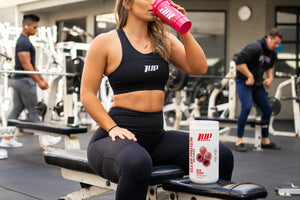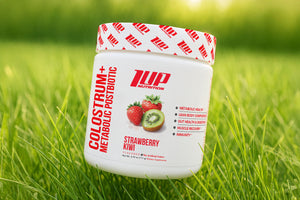We all have some unwanted fat on our bodies, but not all fat is created equal.
Today, we look at the most dangerous type of body fat for your health -- visceral fat -- and discuss why it’s harmful and what you can do to prevent (or reduce) its accumulations.
Let’s get started!
What is Visceral Fat?
Visceral fat is commonly referred to as “belly fat” due to the fact that it is a type of body fat that’s stored within the abdominal cavity.
It’s stored around vital organs, including the liver, stomach, and intestines.
Visceral fat can also build up in the arteries.
However, not all belly fat is necessarily visceral fat.
Some of the fat in your midsection can be subcutaneous fat, which is fat stored just under the skin.
Subcutaneous fat can also be stored in the arms and legs.
Visceral fat, on the other hand, is actually stored inside the abdominal cavity (around your organs), and isn’t easy to see from the outside.
Why is Visceral Fat Harmful?
Research notes a strong link between visceral fat accumulation and metabolic disease, insulin resistance, and an increased risk of death, even for people with normal body mass index (BMI).[1]
Additionally, visceral fat is also is considered to be more closely associated with obesity-related diseases, such as cardiovascular disease and type 2 diabetes, than other indicators of obesity, such as body mass index (BMI), waist circumference, or waist-to-height ratio.[2]
And, visceral fat accumulation is also associated with decreased production of adiponectin, a hormone made by fat cells that is involved in regulating glucose levels as well as fatty acid breakdown. Adiponectin has also been noted to confer beneficial metabolic and anti-inflammatory functions.[3]
Another one of the main reasons why visceral fat is harmful is that it has been noted to increase inflammatory markers, such as IL-6, IL-1β, PAI-I and TNF-α (tumor necrosis factor-alpha).[4,5] Elevated levels of these markers are related to the health problems described above
Subcutaneous fat doesn't carry the same risks as visceral fat. In fact, some subcutaneous fat may even be protective. It’s important to realize, though, that excess body fat (be it subcutaneous or visceral) is hazardous to health and longevity.
How to Prevent/Reduce Visceral Fat
As terrifying as visceral fat sounds, the good news is that you don’t have to do anything drastic, or take any potentially hazardous prescriptions to eliminate it.
All you need is diet and exercise!
Studies have shown that both reduced-calorie diets and exercise can have dramatic effects on visceral fat reduction.[5,6]
Most of the exercise-focused research has been geared towards determining which form of aerobic exercise (“cardio”) is more effective or efficient for reducing visceral fat.
While research shows that both forms are effective at reducing visceral fat accumulation (independent of a reduced-calorie diet), high-intensity interval training (HIIT) appears to lead to greater reductions in visceral fat.
Researchers have theorized that the reasons that HIIT may induce greater visceral fat loss compared to low-intensity steady state (LISS) cardio are:
- HIIT increases levels of pro-fat burning hormones, such as growth hormone and epinephrine, which may help increase post-exercise energy expenditure and fat oxidation (fat burning)[7,8]
- HIIT helps burn more calories on a per minute basis compared to LISS[9]
While much of the focus regarding exercise and decreasing visceral fat has been regarding aerobic exercise modalities, research shows that resistance training can also be beneficial for preventing visceral fat accumulation.
In particular, resistance training helps significantly reduce resting levels c-reactive protein (CRP) independent of weight loss in both sedentary healthy and overweight/obese adults. It also tends to improve adiponectin and lipid profile.[10]
At the end of the day, while either diet or exercise can help you prevent visceral fat, the most effective and efficient way to do so is through combining regular exercise with a healthy diet.
That means in addition to lifting weights 2-4 times per week and performing some form of aerobic training (be it HIIT or LISS), you should also focus on consuming a diet focused on minimally-processed whole food sources, including:
- Lean protein
- Fruits
- Vegetables
- Healthy fats
- Whole grains
And (this really goes without saying), but if you want to limit or prevent visceral fat accumulation, you’d be best served to limit or restrict your intake of added sugar.
The reason for this is that research shows that people who consume more added sugar tend to have more visceral fat.[12]
Along those lines, you also want to watch your intake of alcohol.
Several studies have found that drinking too much alcohol promotes visceral fat storage.[13,14]
The Bottom Line on Visceral Fat
Visceral fat is a very harmful type of body fat that increases your risk of insulin resistance, inflammation, and certain chronic diseases, including heart disease, type 2 diabetes and certain cancers.
Fortunately, visceral fat accumulation can be prevented or reduced by following a healthy diet and performing regular bouts of physical activity.
Furthermore, limiting your consumption of refined carbs, added sugar, and alcohol can also help prevent visceral fat accumulation.
By following the tips outlined above, you can lose (or prevent) visceral fat and improve your health.
References
- Liu FX, Flatt SW, Nichols JF, et al. Factors Associated with Visceral Fat Loss in Response to a Multifaceted Weight Loss Intervention. J Obes Weight Loss Ther. 2017;7(4):346. doi:10.4172/2165-7904.1000346
- Micklesfield LK, Goedecke JH, Punyanitya M, Wilson KE, Kelly TL. Dual-energy X-ray performs as well as clinical computed tomography for the measurement of visceral fat. Obesity. 2012;20:1109–1114.
- Matsuzawa Y, Funahashi T, Kihara S, Shimomura I. Adiponectin and metabolic syndrome. Arteriosclerosis Thrombosis Vasc Biol. 2004;24:29–33.
- Hamdy, O., Porramatikul, S., & Al-Ozairi, E. (2006). Metabolic obesity: the paradox between visceral and subcutaneous fat. Current Diabetes Reviews, 2(4), 367–373.
- Chaston TB, Dixon JB. Factors associated with percent change in visceral versus subcutaneous abdominal fat during weight loss: findings from a systematic review. Int J Obesity. 2008;32:619–628.
- Ohkawara K, Tanaka S, Miyachi M, Ishikawa-Takata K, Tabata I. A dose-response relation between aerobic exercise and visceral fat reduction: systematic review of clinical trials. Int J Obesity. 2007;31:1786–1797.
- Zhang, H., Tong, T. K., Qiu, W., Zhang, X., Zhou, S., Liu, Y., & He, Y. (2017). Comparable Effects of High-Intensity Interval Training and Prolonged Continuous Exercise Training on Abdominal Visceral Fat Reduction in Obese Young Women. Journal of Diabetes Research, 2017, 5071740. https://doi.org/10.1155/2017/5071740
- Pritzlaff CJ, Wideman L, Weltman JY, Abbott RD, Gutgesell ME, Hartman ML, Veldhuis JD, Weltman A. Impact of acute exercise intensity on pulsatile growth hormone release in men. J Appl Physiol. 1999;87(2):498–504.
- Irving BA, Davis CK, Brock DW, et al. Effect of exercise training intensity on abdominal visceral fat and body composition. Med Sci Sports Exerc. 2008;40(11):1863–1872. doi:10.1249/MSS.0b013e3181801d40
- Strasser, B., Arvandi, M., & Siebert, U. (2012). Resistance training, visceral obesity and inflammatory response: a review of the evidence. Obesity Reviews, 13(7), 578–591. doi:10.1111/j.1467-789x.2012.00988.x
- Stanhope KL, Schwarz JM, Keim NL, et al. Consuming fructose-sweetened, not glucose-sweetened, beverages increases visceral adiposity and lipids and decreases insulin sensitivity in overweight/obese humans. J Clin Invest. 2009;119(5):1322–1334. doi:10.1172/JCI37385
- Ma J, Sloan M, Fox CS, et al. Sugar-sweetened beverage consumption is associated with abdominal fat partitioning in healthy adults. J Nutr. 2014;144(8):1283–1290. doi:10.3945/jn.113.188599
- Joan M. Dorn, Kathleen Hovey, Paola Muti, Jo L. Freudenheim, Marcia Russell, Thomas H. Nochajski, Maurizio Trevisan, Alcohol Drinking Patterns Differentially Affect Central Adiposity as Measured by Abdominal Height in Women and Men, The Journal of Nutrition, Volume 133, Issue 8, August 2003, Pages 2655–2662,https://doi.org/10.1093/jn/133.8.2655
- Bendsen, N. T., Christensen, R., Bartels, E. M., Kok, F. J., Sierksma, A., Raben, A., & Astrup, A. (2013). Is beer consumption related to measures of abdominal and general obesity? A systematic review and meta-analysis. Nutrition Reviews, 71(2), 67–87. https://doi.org/10.1111/j.1753-4887.2012.00548.x






